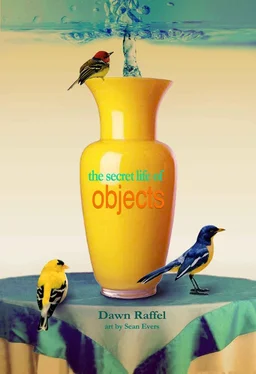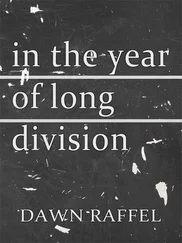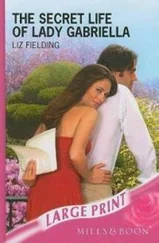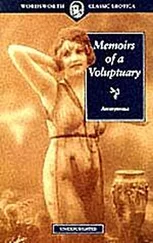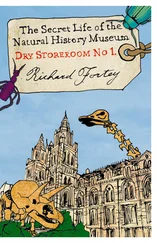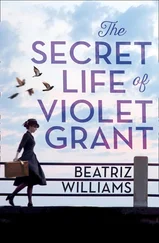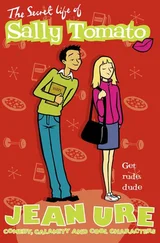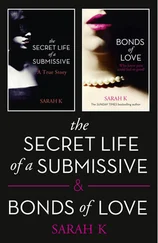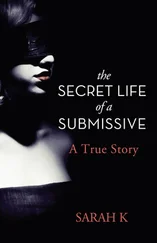I asked my kids if there was anything in particular that they wanted from my mother’s house and they both chimed in: “The peacock feathers!”
“What peacock feathers?” I said.
“Right when you walk in the living room,” Sean said.
“How could you miss that, Mom?” said Brendan.
But miss them I did. What I remembered about my mother’s living room was the heavy glass coffee table, shaped like a flat-topped tunnel, that every child who entered the house delighted in crawling through — until Sean, at two, on hands and knees, by imperceptible fluke shift, caused it to shatter in huge, heavy shards. Amazingly, he emerged without a scratch, frightened only by all the commotion as we picked up hunks of glass that could have cut a jugular, and pulled shard after shard from the thick white carpet. The table was replaced by one in Plexiglas. I remembered, too, the wood-carved statue of the woman who was me as a pre-teenager, and the Saturday hours that I posed in a swimsuit for my mother in her empty classroom at the university, and how, afterward, we’d go out for chili dogs, and how sometimes my mother relaxed and laughed deeply. I remembered the white leather sofa where she’d hold her baby grandsons and where, sometimes late at night, after my stepfather was asleep, we would sit and eat vanilla ice cream drowning in cognac — and how, once in a very great while, she’d tell me a story I’d never heard before: How an aunt, for instance, a woman long dead by the time I was born, had shared my mother’s bedroom after her only child had died. (“She cried herself to sleep every night in the bed next to mine,” my mother said.) I remembered the Oriental desk, crammed with papers and notes meant for me to discover after my mother’s death, and the magenta batik that my mother had made and hung on the wall, and a triptych, in more of my mother’s colors — corals, pinks, reds — occupying the space above the fireplace that she always wanted to fix in some way that I can’t recall.
When I got to my mother’s house, I immediately saw what my children requested: a bouquet of peacock feathers in a gold vase on the floor — eye-high to a toddler, a thing that a child might well remember best, much as I remembered my Grandmother Raffel’s china cat. And so the vase came home, not much worse for travel, the tips of the feathers blue and brilliant green, like seven eyes.
When I picture my father, I picture him wearing a hat. Not a business hat — I don’t believe I ever saw him wearing one of those — but the goofy floppy cotton hats he wore in the sun and the fuzzy faux bombers he wore when he flew or when the weather was cold, as it so often was. (There was also a knitted “Albert” hat left over from the 1970s — Albert being the weather-cat mascot of the local TV station where my father taped commercials for the furniture store. The hat was black and white with a cat’s face made with googly-eyes, a red nose pompon, and whiskers, and with the name Albert written on the brim. I eventually gave it to an art director friend named Albert, who properly appreciated it.) The foremost image I have of my father is of him standing on the wing of his Cessna with a certain suede hat on his head, getting ready for takeoff, a memory that, I’m sure, has been reinforced because I have a photograph of it. Brendan, as a baby, found this hat hilarious; it triggered propulsive glee.
It’s sitting in a bin in my closet. No one wears it.
The Photograph That Proves That My Memories Were Wrong
I have hundreds of photographs taken before the art of the image went digital. Some I snapped myself; others were given to me or inherited. Some are dated; many are not. Although I have discarded the ones that I had no idea who the subjects were, I have many more of people who might be, say, Great Uncle Jack and Great Uncle Max — but I don’t know which is which, and there is no one left to ask. I have far too many pictures of my children, some of them duplicates. Some are in albums, many are not. Some are stuck together from humidity, neglect. I did my best to separate the photos that rightly belonged to my stepsiblings from the ones I meant to keep, but the task was confusing, the lines of family blurred. In the oldest of the images, my stepfather was revealed to me, posthumously, young. My mother’s teenage good looks shocked us all, all over again.
The photo that undid me, though, was one taken of me. Among my clearest memories is that of wrapping a gift to look like a castle, complete with cutout parapets. I remember building the thing in my father’s house, on break from my freshman year in college, cutting and taping in his living room. But in my mother’s drawers I found a picture of myself holding that gift-wrapped castle in the house I grew up in, not my father’s lake house, and by the photo’s date, still at home in high school. The photo made me ill. I thought I might vomit. There was no possibility that there had been two such gift-wrapped packages at different times and places. My memory, a thing I’d have sworn to, was incontrovertibly wrong. What else have I misremembered? What pieces of my past are so ungraspable they’ve shifted shape and form?
If memory serves me, my Grandma and Grandpa Bern once booked an hour in a do-it-yourself recording studio, and cut a 45 of themselves singing together in Hungarian. I looked through every dusty box, every stack of LPs and 45s in my mother’s house; it wasn’t there. Nowadays, people make videotapes, elaborate ones. But that one slim disk was the last place on earth where my grandparent’s voices were trapped in song.
I used to see it only when my mother took me to look in the safety deposit box she kept in the vault at the bank. It is a small copper watch set with rubies that her father bought for her when she graduated from high school. My mother never wore it — at least, not during the years I knew her as my mother. It wasn’t her style and it was small for her wrist. I have always loved that watch. Not long before my mother died she gave it to me, surprised that I wanted such a thing. Despite repairs, its hands move sporadically and it requires winding. Still, I sometimes clasp it on my wrist. It’s yet another watch in the family that marks the hours’ passage in its own sweet time.
My senior year in college the woman in the next dorm room, who was a hallway acquaintance, was giving all of her record albums away. She insisted she didn’t want them. After several rounds of “Are you sure?” I accepted Otis Redding. The next week, I heard she had tried to commit suicide and had been taken home. For the rest of the time I was there, she didn’t return and I never saw or heard from her again. For months I was haunted by the fact that I’d had no clue what was going on in her life, inside her head, on the other side of a thin wall; in fact, I had taken personally her recent aloofness (the album giveaway notwithstanding) and had wondered what I might have done to offend her. This was not my first experience with someone suicidal. In an effort to better understand, I had taken 20 hours of crisis intervention training during my freshman year, qualifying to work on a soon-to-open suicide hotline. (It never took off — we volunteers mostly sat for hours in a cold church basement waiting for the phone to ring.) But by my senior year, my own drama was playing so loudly in my head that I utterly failed to hear that of the woman next door.
I keep that album pressed between the Leo Kotke and Stevie Wonder and John Prine and Beatles and Paul Simon albums I collected in the 1970s. I never hear “Sittin’ on the Dock of the Bay” without feeling a certain nostalgia for a place I have never been, and without thinking of that woman, whose last name I cannot recall.
Читать дальше
